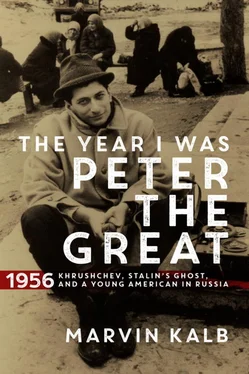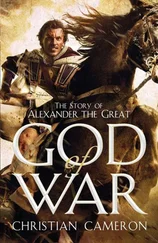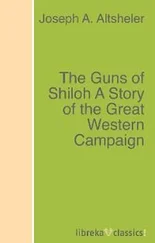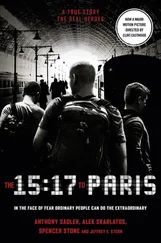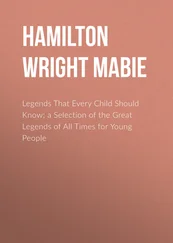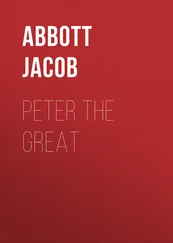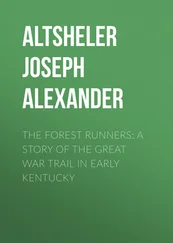In the hotel lobby, a shabby kiosk was the place for the latest news, at central Asian speed. Copies of the Khrushchev speech were piled high. The title for this edition was “Overcoming the Personality Cult of Stalin and Its Consequences.”
I asked the clerk, “When did you get copies of the speech?” In Moscow I had been told it was widely circulated shortly after Khrushchev delivered it in late February.
Here, six months later, the clerk excitedly responded, “This afternoon. It arrived here this afternoon.”
I asked, “Is it selling well?” The clerk examined me with sudden suspicion. He did not answer my question, turning his attention to other customers.
The following morning, after a spartan breakfast of tea, toast, and cheese, I headed for the old city, which the Intourist travel agency vigorously discouraged me from visiting. “Nothing there,” insisted one clerk. “Absolutely nothing there. Uninteresting.” I went anyway. I didn’t think I was being followed, but couldn’t be sure. At a street corner, I asked for directions from an Uzbek woman dressed in a long, black khalat (a long-sleeved outer garment), her face covered by a dark veil. “The trolley,” she replied in Russian, “the number four trolley… to the very end.” She pointed to a trolley rumbling to a stop across the street. I raced toward it, jumping over a rut filled with water. I saw a little boy urinating in it.
The trolley ride cost thirty kopecks, or a few pennies, cheap for an eye-opening spin through time and cultures. I started in the Soviet half of the city (paved streets, tall buildings, Gorky Park) and ended, an hour later, in the Uzbek half. It was like leaving one country and entering another. As the trolley car noisily bounced through Tashkent, I saw the streets becoming narrower, dustier, dirtier, with fewer automobiles but more donkeys and camels. The sun seemed to get hotter and the people poorer, their skin dark, their eyes slanted, their cheekbones set high on broad faces. Buildings were of clay, some of brick. Life here in the old city moved slowly—out of step, I thought, with the rhythm of the mid-twentieth century.
At the end of the trolley ride was Komsomol Square. I found myself facing the ruins of a large mosque. “Closed for repair” signs were everywhere. Like so many other mosques, it was also closed to prayer. Off a main street was the marketplace of Tashkent. It was extraordinary, covering a whole neighborhood with commerce and traffic. Masses of people swarmed through the small, crisscrossing streets, ready to sell or buy anything, from threads to furs. In Soviet society, prices were officially regulated. Theoretically, you were supposed to be able to buy a pound of butter for the same price in Leningrad as in Tashkent. In fact, however, every purchase had its own price. A buyer could scout the available merchandise, spot a possible purchase, and then haggle over price for long stretches of time. Every kopeck was like a gold coin. I heard an old man argue with remarkable passion, pointing his finger and yelling about a twenty-kopeck difference between his offer and a seller’s price for half an hour—and then dramatically walk away. The seller lingered for a few minutes and then raced after the man, knowing that in a bazaar the negotiation never ended. Ultimately the seller yielded, the difference between their prices now dropping to five kopecks. The deal was struck.
In this marketplace, everywhere, leaning up against walls and checking the passing parade of potential buyers, were the sons and grandsons of the famous Basmachi, Islamic fanatics who opposed communism before and after the Russian Revolution. When Tsar Nicholas II tried to conscript central Asian Muslims into the Russian army during World War I, many went into rebellion and under the leadership of Enver Pasha, a former Turkish minister of war, formed a guerrilla army of 16,000 rebels. Enver Pasha, who looked to Timur the Lame as a model, dreamed of establishing a Pan-Turkic confederation encompassing all of central Asia. In a series of vicious battles in the early 1920s, the Russian communists beat down the insurgent Basmachi, and by the early 1930s the Islamic movement fizzled, having run out of both drive and energy, even though nostalgic tales of Basmachi courage could still be heard in hushed conversation in shady corners of the Tashkent marketplace.
Language was crucial to communist governance in central Asia. In the early 1920s, during the hot years of the Basmachi insurgency, the Uzbek language was written in Arabic script, leaving communist overlords feeling decidedly uncomfortable. They could not exercise total control if they could not read Uzbek script. Making matters worse, the Turks had just changed their script from Arabic to Roman, as they sought to modernize their society. Soon thereafter, the Uzbeks followed suit—they also changed their script to Roman. For the Russians this was a step too far. They angrily ordered that henceforth the Uzbek and other central Asian languages would be written in the Cyrillic script, like Russian. And so it has been since the late 1920s: every word in central Asia was written in the Cyrillic script. Because I knew Russian, I could read headlines in newspapers and street signs in the old city, but because I did not know the Uzbek language, I could not understand a single word.
I decided in mid-afternoon to walk back to the hotel. It was a three- to four-mile journey. It was hot, and with each step I felt that I was picking up part of the pavement, softened by the relentless sun. As I started, I spotted an old woman riding an even older donkey. She was not wearing a veil, which surprised me, and she looked like a queen, sitting atop the donkey in regal fashion. From her bearing it was clear she had survived the communist takeover with her personal dignity intact. Most others could not claim such distinction, walking slowly, shoulders bent, faces drawn with daily worries. I could not have imagined seeing a prouder figure in all of Tashkent than the old woman on her donkey.
A huge statue of Stalin dominated one small square. It made him look like a Greek god, muscular and omniscient. People walked around it, as I did, but they paid no attention to it. I did, taking a picture of it and in so doing attracting quizzical stares from Uzbeks passing by. In another square I took a picture of an Uzbek man sitting in a small cart and snapping a thin stick across his donkey’s backside. He saw me but did not object. In fact, he asked, “Did you get a good shot?”
“I hope so,” I answered.
“You from Moscow?” he wanted to know.
“Yes, I’m from Moscow, but I’m not a Russian. I’m an American.”
The Uzbek seemed incredulous. “An American? Here? I guess things are really better, like they say, if you can actually meet an American in Tashkent these days.”
Slowly, block by block, the old city began to slip out of focus, replaced by images of the new Soviet half of Tashkent: paved streets, brick buildings, cars, buses, a woman in shorts carrying a tennis racket, young men on motorbikes. And, everywhere, statues of Stalin, far more than statues of Lenin. In the Museum of Art, near the hotel, two favorites from Russian history were on display. One was Peter the Great, who launched Russia’s imperialist drive into central Asia in the early eighteenth century, and the other was Stalin. Dozens of paintings and statues of him, large and small, were everywhere, the ubiquitous portrait of Kremlin power. Khrushchev had taken a hammer to the late dictator’s reputation, but obviously it was going to take a long time for the first secretary’s startling message to spread, and be accepted, throughout this vast country.
After I returned to the hotel I noticed a plaque to the right of the main entryway stating that the hotel had been headquarters in 1920 for the Russian army sent to central Asia to establish communism and demolish the Basmachi.
Читать дальше
